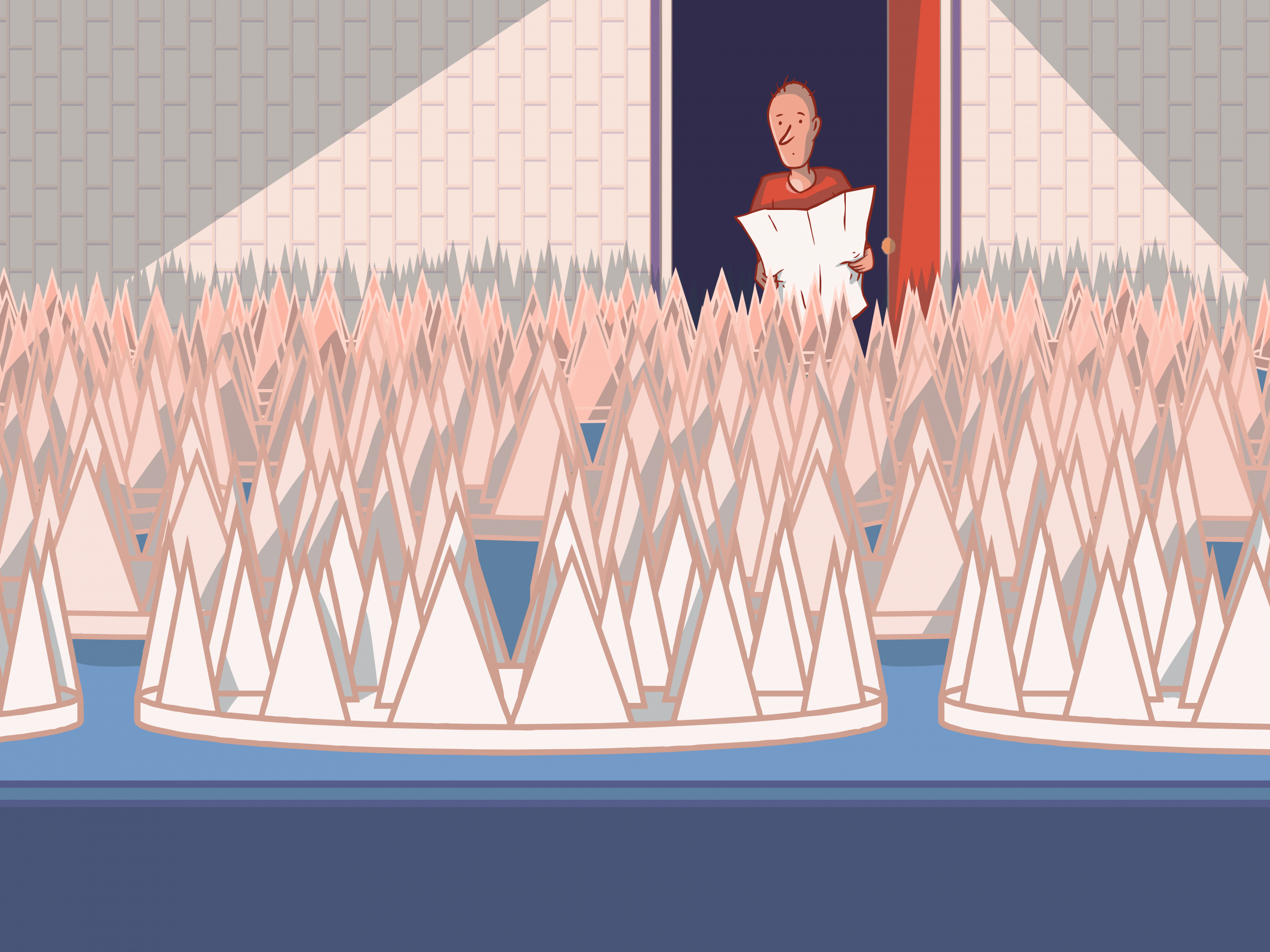Can lying on a bed of nails relieve lower back pain?
Christine Manby is determined to find out – and along the way discovers that the mats, which are made exclusively by women in the Gratitude factory, can also dispense karma


Let’s talk about pain. Regular readers of this column (hello, Mum!) will know that I spend half my life doing Pilates to strengthen my lower back and the other half of my life looking for ways to ease the agony of Pilates-related lower back injuries. Physio, chiro, daily cold showers, weird breathing techniques... I felt like I’d tried everything until I saw a Shakti mat.
As a child, I was fascinated by a photograph in an encyclopaedia of a fakir, naked except for a very small loincloth, lying on a bed of nails. Actual nails, hammered through a wooden board so that they were vertical and the fakir was on the pointy ends. How was it possible that he wasn’t writhing in agony? On the contrary, he seemed relaxed enough to have fallen asleep. I was sure there must be some trick involved. Either that or he was dead.
Four decades later, I’ve had acupuncture on my back a number of times: just four or five needles to ease the muscle spasms that accompany disc slippage and can age one by a hundred years in a day. Apart from one occasion, those acupuncture needles turned out to be hardly noticeable, much less uncomfortable, and – perhaps I was imagining it – gave some relief. So surely more needles should equal faster recovery?

A Shakti mat is a cotton covered foam mat about half the length of a yoga mat covered in coin-sized white plastic discs which are, in turn, covered in spikes. The idea is that when you lay down on the mat, those spikes give you a DIY acupressure massage, designed to ease muscle tension and improve circulation. “Side effects” may include increased vitality, better sleep and stress reduction.
I chose the yellow mat (£49), which is designated “lightest” and is apparently ideal for beginners. It was hard to tell from the pictures on-line what the real difference between the mats actually was, apart from the colour of the cotton, but I assumed that the beginner’s mat would be, I don’t know, less vicious? Perhaps the spikes would be rounded off at the ends? Reading closely, I learned that the yellow mat has 2,000 more spikes than the original. I know how the physics about weight distribution works but still… When the mat arrived, those spikes did not look like beginners’ spikes at all.
But how did it feel? I tested the mat’s general spikiness with my foot first, tentatively placing one sole down on the white discs but not daring to put my full weight onto it. Those spikes were not immediately friendly. I had visions of puncturing myself and squirting gouts of blood all over the living room floor. When that didn’t happen, I prepared myself to lie down.
And to begin with, it felt exactly as you would imagine laying down on a bed of sharp plastic needles to feel. It felt as though I’d lain down on a bed of sharp plastic needles by mistake and ought to spring straight up again as a matter of urgency. Except that because I was wearing a T-shirt – as recommended for first timers – the spikes had penetrated the soft cotton and were clinging on like the spiny bracts of a teasel.
If I stood up, I suspected the mat would get up with me. Also, I have a dodgy disc. Lately, I don’t spring up from anything. I have to roll onto my side and half-rise like the hero of an old school western who’s just been shot in the guts but knows he has to rally one more time to save the bad guy. Yep. It’s that bad. So, I was stuck on the floor, stranded like a beetle that’s been rolled over. There was no getting off those spikes. I had to stay on them. And breathe…. Breathing is the secret, apparently. Deep, calm, and all that.
The leaflet suggested staying on the mat for just a few minutes to begin with. Isn’t it strange how time seems to contract or expand according to what we’re doing with it? I had thought, prior to my first experience on the Shakti mat, that the very longest minutes were Pilates minutes. The minutes when you’re using your lower abs to hold your legs in the air in the Teaser (a vile exercise that should be called The Torturer), can stretch for days. I’ve plotted entire novels while holding that hideous position for 60 seconds. At the other end of the scale, of course, are Facebook minutes, 45 of which can pass in the blink of an eye.
For the first day-long minute on my new Shakti mat, my entire body tensed against the plastic pricks. Then it was as though my muscles gave up. They couldn’t possibly get any tighter so they started if not to relax then to release. I sank further down onto the mat. The Shakti mat website has a useful timeline illustration that explains the evolution of a 20-minute session. For the first 10-20 seconds, “the skin feels uncomfortable and prickly, and the body wants to resist”. After 20 seconds, “the body starts to move blood to the area”. After one minute, “the skin gets warm and feels almost sunburnt”. Two minutes and “a tingly effect begins, similar to deep heat”. At the four-minute mark, “full body restoration starts to take over”. By six minutes, “muscles start to feel relaxed, and tension eases, leaving people feeling ‘blissed out’”. And if you can make it to 20? The Shakti Mat website claims that “some people have said they start to nod off to sleep”.
I didn’t nod off to sleep, but I definitely felt an increasing sensation of warmth that continued when I – slowly – got back up again. There were no visible holes in my T-shirt or my skin. Just the sort of “loose” feeling one gets after a massage. Relief at getting off the mat perhaps? Whatever, as I sat back down at my desk to transcribe an interview, I continued to feel surprisingly relaxed. The 120 five-star reviews the mat’s been given didn’t seem so unlikely after all. When I’d finished work for the day, I had another couple of minutes on the mat and I’ve been going back to it every day for the two weeks since.
There are lots of similar mats on the market, ranging from £15, but Shakti mats are a little more expensive for good reason. They’re made in India in the charmingly named “Gratitude Factory” in Varanasi, an all-female workshop with a staff of 72. The Sanskrit word “Shakti” itself is feminine, embodying empowerment, abundance and change.
The cotton covers are sewn on old-fashioned Singer machines and the plastic spikes are attached by hand. The cost of a Shakti Mat includes a portion that goes straight back into the community. The website claims: “We support the women who work there with good salaries, good working hours, a happy work environment, free meals, and holiday pay. We also provide them and their families with free healthcare.” Shakti mats are also funding the schooling of a number of their employees’ daughters.
Geeta, 32, who works in the factory, said: “I feel like I’m part of a family, all these women are like my sisters. We are all from different castes and religions but all of us are treated equally, there is no discrimination between us. I feel as if I belong here, people are affectionate as well as helpful and then there is the amazing work we do. I feel very dedicated to this place, it feels like my real home.”
So Shakti mats don’t just feel good. They can also, it seems, enact swift karma. A visiting friend strode across the living room to sneer unkindly at my ancient fake Christmas tree. He put his sock-clad foot square in the middle of the Shakti mat as he did so. It was a useful reminder that when not in use, Shakti mats, like Lego, are best safely stowed away.
To download Chris Manby’s ebook on wellbeing go to /independent-premium#ebooks.
Join our commenting forum
Join thought-provoking conversations, follow other Independent readers and see their replies
Comments
Bookmark popover
Removed from bookmarks